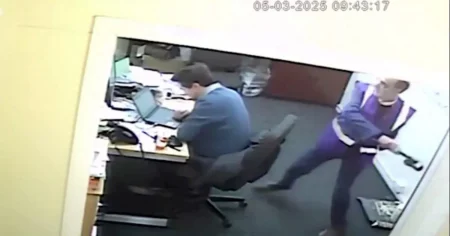The serene grounds of Sefton Parish Church, a historic landmark nestled within the bustling metropolis of Liverpool, became the unexpected stage for a deeply distressing saga of misplaced remains and bureaucratic oversight. For over a decade, a couple rested peacefully in a grave believed to be their final resting place, only for their family to be confronted with the agonizing revelation that their loved ones had been mistakenly interred in a plot reserved for another. This shocking discovery necessitated the exhumation of the couple’s remains, a process fraught with emotional turmoil for their grieving family, and forced the church to issue a heartfelt apology for the administrative blunder that compounded their loss.
The incident, which came to light recently, exposed a series of systemic failures within the church’s burial record management. The initial error appears to have stemmed from a misinterpretation of historical burial records, possibly due to ambiguous or incomplete documentation. This initial misstep, however seemingly minor, triggered a cascading series of oversights that allowed the mistake to persist undetected for years. The lack of a robust system for verifying burial locations against existing records, coupled with inadequate communication between church officials and burial plot owners, created an environment ripe for such a devastating error to occur. The resulting confusion not only caused irreparable emotional damage to the affected family but also tarnished the reputation of Sefton Parish Church, a place of solace and spiritual comfort for generations of parishioners.
The exhumation process itself was a deeply traumatic experience for the family. Having already endured the pain of losing their loved ones once, they were forced to relive that grief as they witnessed the remains being disinterred. The process, inherently unsettling and emotionally charged, was made even more agonizing by the knowledge that this upheaval was entirely avoidable. The family had to confront the reality that their loved ones had not rested in their intended final resting place, shattering the peace they had found in believing their loved ones were at peace. The exhumation served as a stark reminder of the bureaucratic failings that had led to this heart-wrenching situation, compounding their sense of betrayal and loss.
Beyond the immediate emotional impact on the family, the incident raised serious questions about the church’s internal procedures and accountability. The public apology issued by Sefton Parish Church acknowledged the gravity of the situation and expressed sincere remorse for the distress caused. However, an apology, however sincere, cannot fully undo the damage inflicted. The incident underscores the critical need for a thorough review of burial record management practices, not only at Sefton Parish Church but also within other religious institutions and cemeteries. Implementing stricter protocols for verifying burial locations, digitizing historical records, and improving communication between stakeholders are essential steps towards preventing similar occurrences in the future.
This unfortunate incident serves as a poignant reminder of the importance of meticulous record-keeping and clear communication, especially in matters as sensitive as burial arrangements. The emotional toll exacted on the family highlights the devastating consequences that can arise from seemingly minor administrative errors. The case of Sefton Parish Church stands as a cautionary tale, urging religious institutions and cemeteries to prioritize accuracy and transparency in their record-keeping practices. Furthermore, it emphasizes the need for clear lines of responsibility and accountability within these organizations to ensure that such devastating errors are identified and rectified promptly.
The path forward for Sefton Parish Church involves not only rectifying the immediate situation but also implementing long-term solutions to prevent similar incidents from occurring. This includes a comprehensive review of existing burial records, the development of a robust digital record-keeping system, and the establishment of clear communication protocols between church officials, burial plot owners, and funeral directors. It also necessitates a cultural shift within the organization, prioritizing meticulous attention to detail and a commitment to transparency and accountability. By learning from this painful experience, Sefton Parish Church can emerge stronger and more resilient, ensuring that the final resting places of its parishioners are treated with the respect and reverence they deserve, preventing further heartache for grieving families in the future.














